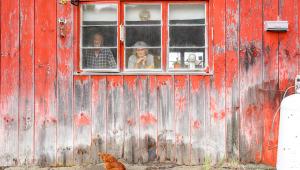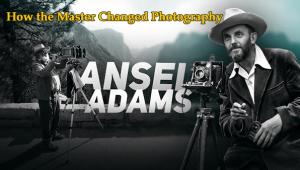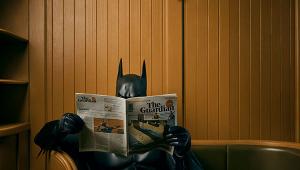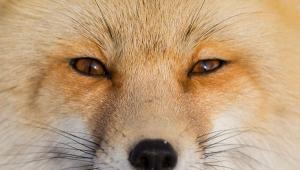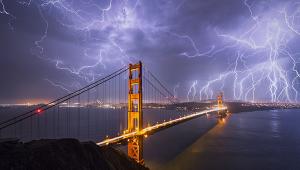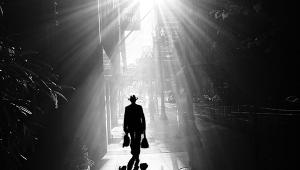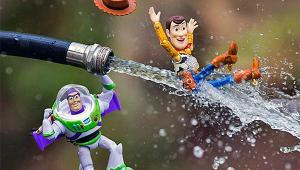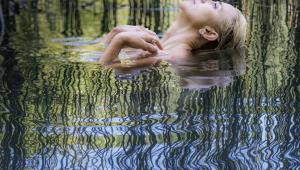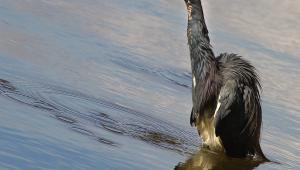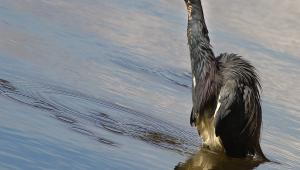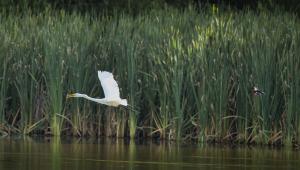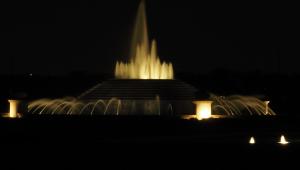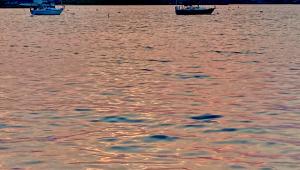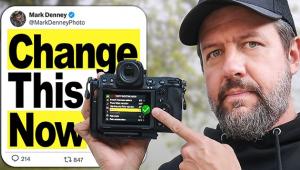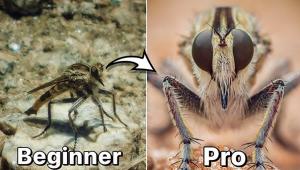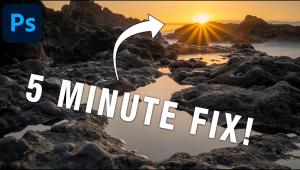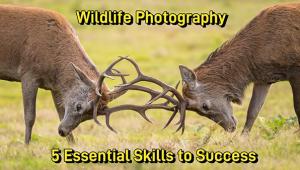Corporate Photographer Jim Karageorge Stays Competitive by Adapting to the Times

Jim Karageorge has been an eyewitness to the changing face of corporate photography over the years. “Today, the stories that corporate clients want to tell are different from those we told in the past,” Karageorge, a corporate/industrial photographer, observes. “They are geared more toward the human factor than the technologies.”
He explains: “The one thing that companies can’t do without is photographs of people that work for them. Whether these are portraits or workplace shots, it’s not something the client can get from stock.”
Another change centers on format. “My print-oriented analog shots were largely verticals shot on 120 film on location, and a mix of 120 and 4x5 in the studio. Now all I use is the 35mm format—for everything. The other thing is that many of the digital shots are horizontals. Why horizontal for digital? Because the web is horizontal. What I was shooting for annual reports, I am now shooting for the web.”

Karageorge produced these R&D shots for an annual report, working off the client’s layouts, and shooting on a Sinar F on 4x5 Kodak Plus-X, then scanning and tinting in post. Karageorge worked his magic to add life to otherwise lifeless subjects. The shot of a magnetic substrate (purple-toned) was the more complex of the two, owing to the laser, and involved Norman Tri-Lites, Dynalites, and Rosco Tough Rolux in combination to create this sci-fi effect. The lights were shut off for part of the exposure, while an assistant dragged a business card through the laser beam in order to get the brightness and coherence of the beam. The second shot features a lab test bench.

This shot features a high-density disk drive, with an innovatively designed, translucent flying head. The purpose of the shot was to highlight the circuitry in the head, which reads the data in the platter. Karageorge shot this on 4x5 film, with lights positioned behind sheets of Tough Rolux on which color gels were placed. Each color (red, yellow, orange, cyan) represents a separate light source, combining to make an otherwise drab subject pop. Shots such as this consumed four to six hours of intensive effort in the studio, with each light carefully placed, and the colors juxtaposed in precise fashion.
Maintaining A Competitive Edge
“I’ve always done a lot of location work,” Karageorge notes. He attributes his location shooting style to his documentary film background in graduate school, where he learned the art of storytelling with imagery. “But I also did a fair amount of studio work. Digital has largely led to the near extinction of studio work in this sector of the business, because of the availability of stock and the need for a more reality-driven photojournalistic approach.”
He continues: “Shooting on location is physically demanding. Contributing to that is the digital medium. There is more pressure these days to get more done on a daily basis (than when I shot film). The one thing in common between then (film) and now (digital) is this: You still have to keep your edge.”

Having instructed each person on wardrobe in advance, Karageorge spent two days at the offices of the architectural firm, photographing each of the senior-level staff and the principals of the firm, for their website. Shooting with a Nikon D3 and an 80-200mm Nikkor, he set up a 4x6-foot softbox with Tough Rolux in front as his key light, adding a kicker light, plus two lights copy stand fashion washing the backdrop and a foamcore fill card at camera right. Karageorge used various filters in Photoshop and Nik Color Efex Pro for effect. (Agency: Beal Creative.)
The Path To Corporate/Industrial Photography
Karageorge’s photojournalistic beginnings started as an undergraduate at Yale. “I had a roommate who was from Rochester and way into photography, which rubbed off.” Karageorge’s burgeoning interest in photography paid off, leading to a position as a shooter for the Yale Daily News and photo editor of The New Journal, a campus magazine.
He started with a 35mm Konica Auto-Reflex, but quickly learned that what he needed was a more robust camera. So he outfitted himself with a Nikon F, a 50mm f/2 Nikkor, and a handheld meter. “I was learning the Zone System and shooting a lot of Tri-X, from a photojournalistic viewpoint.” The year was 1973.
We next see Karageorge as a graduate student in the Stanford University film department where, owing to his prior experience in still photography, he was asked to produce a slide show of the San Francisco Bay Area intended to lure new businesses. “Part of that job involved shooting at various corporate sites. This was the launching point to my career as a corporate/industrial photographer.” He marks the start of his professional career as the year he shot his first annual report in 1977, around two years following that college shoot.

We don’t usually see a tilt-shift lens in portraiture, but that, together with a wide aperture, is exactly what Karageorge used to focus attention on the man standing, who is the client of the real estate firm he was meeting with (the people seated, who, in fact, represented the photographer’s client). There was an assistant just outside the door, on the left, hand holding a rented battery-powered Profoto with a 2x3-foot softbox on it, adding a rim light. “We were in and out—if you include going into the restaurant and asking for permission, waiting for the area to be cleared (without asking people to leave, because we weren’t going to disturb any customers), and then getting the people in place—probably a half hour to 45 minutes.” Karageorge picked this spot because it was recognizable and more relatable to people who would see the ad. (Agency: Twist Studios.)
Getting In Gear
Professional life in the 35mm lane was running smoothly, till he hit a snag. “While I was in the middle of shooting an annual report in 35mm, the art director on the project said, ‘We need more drama and we need to see everything larger.’ So, to protect my business, I invested in my first Hasselblad. And several years after that, a Sinar F. I adopted the mantra that I had to be prepared to shoot at the highest quality on any job, and to be adaptable to any situation.”
Even before he went fully digital, Karageorge was having film scanned and editing in Photoshop. “My first digital camera was a Kodak DCS Pro 14n, so I could use the Nikon lenses I owned. As soon as Nikon made a DSLR I could be happy with, I switched back.” That was a Nikon D200, although he was itching for a full-frame camera. “Now I’m using a D3 and a D800. I’m always looking at how the tools are changing, to keep that competitive edge.” The switch to digital did not mean Karageorge abandoned his old lenses. “I’m still using all my old Nikkors.” Nikkor lenses old and new include a 300mm f/4.5, 80-200mm f/4, 18mm f/3.5, full-frame fisheye, and 45mm tilt-shift.
While he owns several tripods, namely, a venerable Bogen (his go-to pod), an old Majestic with extended reach, and a newer carbon-fiber Gitzo, the DSLR gives Karageorge the option to shoot handheld much of the time. “Even with portraits, I may start on a tripod, but in order to imbue the image with more spontaneity and dynamism, I switch to handheld. I need to move around; I need to have different looks.”

This shot aims to promote the use of recycled rubber tires in asphalt. “When your client asks you to shoot a crew laying down asphalt, the most dramatic situation I could think of was to shoot this at night, to which the client agreed.” This was shot on Highway 101, in Northern California. “This piece of equipment has built-in, broad incandescent lights. So I cranked up the D3 to ISO 2500, which I tested to ensure it would hold up for a double-page spread in print. And I had an assistant off to the left with a battery-operated Lumedyne (with cool gel) clamped to a telescoping pole to add some backlighting to the scene without overwhelming the shot. And then I applied selected filters in post for an even more surreal feeling.” (Agency: Beal Creative.)
No Room For Compromise
For Karageorge, the image remains sacrosanct. “I’m not going to compromise the image, even though I have many more pictures to shoot in a day now.” For this reason, he still heads out with a full kit, “the same lights I used in my analog days.”
What comprises that full kit? It has gone on a diet, but it still has plenty of muscle, revolving around an AC-driven Dynalite power pack system, while including Norman specialty heads (notably the Tri-Lite) and a DC-powered Lumedyne. “Now I go out with five to seven heads and two packs. I’ve always believed in redundancy, because I recognize it’s a service business. I’ve got to have two of everything. I cannot go out there and not deliver.”
His kit also includes a supply of Rosco Tough Rolux diffusion (www.rosco.com), which he places in front of a softbox to better shape the light. Karageorge adds: “I’m still using high-output packs, but at lower power because I’m increasingly shooting wide open, employing selective focus and shallow depth of field.” Part of the job often involves scouting locations to get the lay of the land, or, more importantly, the light, all in an effort to be prepared for any eventuality.
These days, to give himself an even greater competitive edge, Karageorge is using his Nikon D800 to shoot video. “What people don’t understand about video is, sound is content. If you’re doing corporate, the visual side of things is only 25 percent of what you’re after. Seventy-five percent is about what’s being said.”
Jim Karageorge is based in San Francisco. To see more of his work, visit www.karageorgestudio.com.




